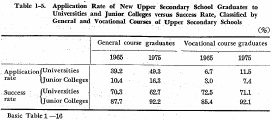| Home > Policy > White Paper, Notice, Announcement > White Paper > EDUCATIONAL STANDARDS IN JAPAN 1975 > CHAPTER1 4 (2) c | ||
Comparison between new graduates of the general course of upper secondary schools and those of vocational courses over the rate of application and the rate of successful applicants to universities (undergraduate courses) and junior colleges (regular courses) is made in Table 1-5.

In 1975, graduates of the general course showed a higher rate of application (49%) to universities than those of vocational courses, whose application rate stood at 12%. During the last ten years, the rate of application increased 10% among the graduates of the general course, as against only 5% among those of vocational courses. As for the rate of successful applicants, however, graduates of vocational courses showed a higher rate, 71% in 1975 than did graduates of the general course, whose rate of success stood at 63%. During the last ten years, the rate of successful applicants dropped for both of these two types of graduates, but the 1arger decline was shown by graduates of the general course.
In 1975, graduates of the general course showed a higher rate of application, 16% than the 7% shown by the graduates of specialized courses, whereas the rate of successful applicants was the same 92% for both of these two types of graduates.
| Back to Top | MEXT HOME |